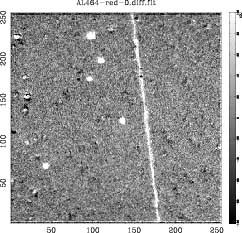DIFFERENCE IMAGING
In order to extract the maximum possible amount of information from microlensing light curves, the photometry needs to be carried out as accurately as possible. The MOA group uses the technique of ‘difference imaging’ that was developed by Alard and Lupton (ApJ, 503, 325, 1998). This takes advantage of the large amount of information that is available in images of dense stellar fields, and achieves a photometric precision per star that is close to the photon statistical limit.
Difference imaging is applicable to objects or varying luminosity only, and as such is well suited to searches for examples of gravitational microlensing in dense stellar fields. Faint stars that are highly magnified may be efficiently found using the technique astro-ph/0102181. These provide promising hunting grounds for extrasolar planets and dark matter (astro-ph/0004137, astro-ph/0111041, astro-ph/0204478 and astro-ph/0208399).
The difference imaging technique is illustrated below. This shows the difference image for a dense stellar field and a reference image which was traversed by a satellite. The track of the satellite is clearly apparent.

Difference image of a dense stellar field showing the track of a passing satellite.
